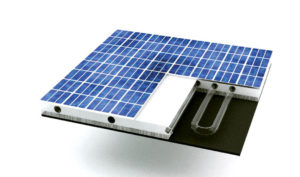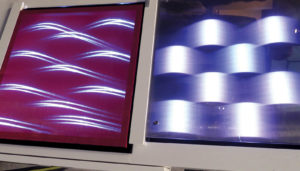
Recent advances in thermal control for apparel have grabbed the headlines in this type of textile technology, but there are highly sophisticated materials and technologies that are less obvious, but at least as impressive, especially in building interiors and exteriors and other energy-saving applications in everyday life.
Depending on the desired outcome, an approach to thermal control can take several forms: by physical means, such as shape-shifting textiles that open a vent or “pore” to let heat out of, or into, a device’s textile cladding; by reflecting heat or light away from the surface; by moving heat around en masse, most often in the form of a phase change material (PCM); or by some combination of these approaches.
These methods are being applied to products in an ever-growing number of industries, such as automotive/transportation, architecture and construction, solar thermal energy systems and in medical devices or processes.
Shape shifters
Several university research labs are exploring the effects of temperature-responsive materials, including textile fibers. The Massachusetts Institute of Technology (MIT) interdisciplinary research laboratory, the Self-Assembly Lab, recently announced its work on a number of heat-active auxetic materials that respond to external factors and hold the potential for programmable switching or sensing applications.
The Self-Assembly Lab’s research involved combining multiple materials with different thermal expansion properties. A unique subcategory of this research is what they call “programmable materials,” which are materials that have “compositions designed to become highly dynamic in form and function, yet are as cost-effective as traditional materials.” Some of this involves the technologies of multi-material 3-D/4-D printing, new advances in materials science and enhanced capabilities in simulation/optimization software.
The Lab’s “Programmable Textiles” are made by printing material in varied layer thicknesses onto stretched textiles. According to a published report, researchers are able to create self-transforming structures that reconfigure into pre-programmed shapes that are heat-activated in response to external factors while adapting to various stimuli. These traits, they suggest, would be particularly useful in clothing, furniture, packaging materials and crash-protection equipment. Other possibilities explored by MIT’s lab include custom textile composites, printed wood grain and self-transforming carbon fiber.
Reflecting brilliance
A recent development by scientists at NASA’s Jet Propulsion Laboratory (JPL) in Pasadena, Calif., produced a form of fabric with reflective metallic surfaces that could be used to protect spacecraft from meteorites, cover large antennas or deployable devices, or in other Space applications.
Similar to chain mail in appearance, the 3-D printed fabric consists of small silver squares threaded together so that the fabric remains flexible. One side of the fabric reflects light; the other absorbs it to render a means of passive thermal control where it is applied. This concept is actually the basis of most building solar control, where the maximum efficiency and effect can be produced by means of shading devices that block direct solar heat gain and thereby mitigate the effects of thermal buildup.
Change for change’s sake
Perhaps the area where the greatest activity of research and potential for transfer to market applications is occurring is in phase change materials (PCM). This is not surprising given that PCMs are substances with high heat of fusion, that—while going through the transition from melting to solidifying at certain temperature ranges—are capable of storing and releasing large amounts of energy.
It is also an area of materials development benefitting from more than four decades of testing, marketing and application in building and construction. The 2013 ASHRAE (American Society of Heating, Refrigerating and Air-Conditioning Engineers) report by Jan Kosny and Elizabeth Kossecka for the Fraunhofer Center for Sustainable Energy Systems, Cambridge, Mass., “Understanding a Potential for Application of Phase-Change Materials (PCMs) in Building Envelopes,” states that historical studies found that PCMs have notably improved building energy performance.
“Some PCM-enhanced building materials, such as PCM-gypsum boards, PCM-impregnated concretes, or PCM-enhanced fiber insulations, have already found limited applications in different countries. Today, continued improvements in building envelope technologies suggest that throughout southern and central U.S. climates, residences may soon be routinely constructed with PCMs in order to maximize insulation effectiveness and maintain low heating and cooling loads,” the report says.
According to Kosny and Kossecka, when PCMs are used to help control thermal processes, with the special case of buildings “the major role is to mitigate energy fluctuations and to slow down the energy transport process of external thermal loads to the interior of the buildings,” unlike with many applications in other fields where very fast thermal changes need to occur, such as in electronics, telecommunications, shipping, and automobiles.
Moreover, Kosny and Kossecka state that all PCMs used in building envelopes “need to go through a complete phase transition during 24-hour time periods in order to be fully effective. This is why it is critical that the temperature in the location where the PCM is installed is circulating (possibly daily) above and below the PCM functional temperature range,” to gain the maximum effect of the thermal transfer. This means that the use of PCM-enhanced building materials may not be practical in all climates and are more efficient in those that consistently cycle through the specific ranges of the PCMs that are used for thermal control.
One very positive outcome of these studies is that many of the materials that work best for this application are made from organic fatty acid esters made from underused feed stocks, such as soybean oils, coconut oils, palm oils and beef tallow. “Because these esters are fully hydrogenated,” the study states, “the fatty-acid ester PCMs are expected to remain stable during thousands of phase-change cycles with no risk of oxidation.”
Combinations for better results
Other researchers are finding novel combinations of new materials and more traditional technologies. A recently published report by Dr. Barbara Pause, president of Textile Testing & Innovation LLC, Longmont, Colo., suggests that combining photovoltaics with spacer fabric backing, called a textile-based hybrid photovoltaic thermal system (PV/T), results in a higher efficiency of operation. Most conventional PV/T collectors are bulky and heavy PV panels that in tandem with solar thermal collectors have issues with efficiency in heat transfer to a heat exchanger.
“Operating these systems requires a steady flow of fluid or air throughout the day to keep the PV cells cool and to make them more efficient,” says Pause. The fluids typically used in these systems are water, glycol or mineral oil, which are pumped through metal pipes. Heat from the PV panels is conducted through the metal, absorbed by the fluid or air and transferred to the heat exchanger. And these PV/T systems can cost up to 25 percent more than conventional PV systems.
In a paper published in March 2017, Textile Testing & Innovation proposes a textile-based PV/T system composed of a spacer fabric integrated with thin pipes through which water is circulated only to cool the sandwich fabric composite as needed. The back side of the spacer fabric is covered with a protective coating to withstand the elements; the front side of the spacer fabric faces thin-film PV cells and is coated with a silicone compound containing PCM to act as the thermal storage means. The thin-film PV cells are laminated to the surface of the silicone layer.
“The thin-film PV cells convert the solar radiation into electricity. As soon as the temperature of the PV cell reaches a given trigger temperature,” says Pause, “the excessive heat is absorbed by the PCM integrated into the silicone compound. In this way the PV cell is cooled and can operate at its optimal temperature, at highest possible efficiency and maximum electrical output.”
According to Pause, this PV/T thermal system is more efficient than the forced liquid/air cooling system used in commercial applications because this approach provides direct contact between the PV cell and the heat absorber. Pause also notes that there is no need for a constant flow of water or air in this system, only operating when needed. The new system is also expected to be more cost effective, more versatile and require less maintenance than current systems.
Bruce N. Wright, AIA, a licensed architect and consultant, is a frequent contributor to Advanced Textiles Source, Fabric Architecture, and Specialty Fabrics Review.
German manufacturer Ettlin has developed a range of 3-D LED lighting panels to create dramatic optical effects for architectural interiors. The company’s latest iteration offers climate control and weather resistance that allows for transparency and protects against UV radiation. The material protects against the buildup of humidity and allows excellent air permeability. Applications extend beyond architecture to include potential uses in automotive interiors.
 TEXTILES.ORG
TEXTILES.ORG



